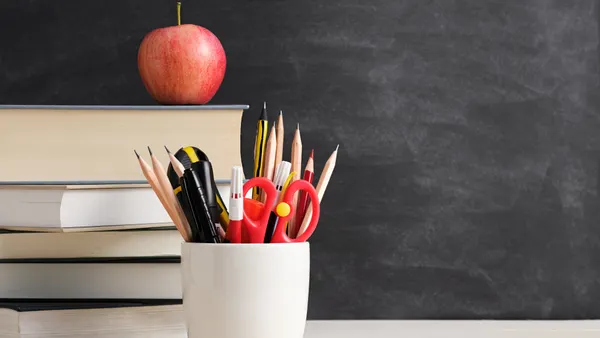Today’s K-12 students are digital natives. And educators wouldn’t be wrong for thinking they tend to be more engaged in their learning when interactive technology is part of the experience, says Theo Miron, a nationally certified school psychologist and assessment consultant for Pearson. After all, it’s part of their everyday lives: Most teens use or have used social platforms like YouTube (95%), TikTok (67%) and Instagram (62%), a Pew Research Center study found, and about two in five respondents said they spend too much time on social media.
However, it’s no secret that too much screen time for kids and teens can be a concern. Studies have found negative impacts of screen time to include higher rates of obsessive-compulsive disorder diagnoses and more difficulty self-soothing. Excessive screen time has also been found to negatively affect math and literacy grades in school-age students.
Yet edtech continues to be a huge part of the classroom experience. School districts used nearly 2,600 ed tech tools on average in the 2022-2023 school year. As technology continues to reshape how students learn, Miron notes that educators must strike a balance between leveraging digital resources for educational enrichment and recognizing when students might need a screen break for their mental health.
By making thoughtful choices, Miron says, educators can empower their students with the best of both worlds: harnessing the power of technology while fostering a supportive and mentally healthy learning environment.
Tips for balancing bytes and books throughout the school day
Is your school or district aiming for a healthier mix of online and offline approaches? Here is some inspiration for building a well-rounded school day that embraces the advantages of technology while allowing students to explore the benefits of in-person experiences.
Literacy
Technology can be an engaging complement to any reading program, affordably facilitating increased access to learning materials. Incorporating different mediums can help connect students with diverse perspectives and timely sources while providing wraparound literacy support for emerging readers.
Students should still be exposed to the printed word, however, as doing so may help them absorb more information and can improve attention spans that may be prone to screen-related distractions.
Math
Adaptive online math exercises are useful ways to tailor learning to each student’s proficiency level and give extra practice with skills they haven’t mastered. They also can offer educators data-driven insights to customize lessons.
However, pairing them with interactive and manipulative activities, like puzzles and design challenges, can make abstract math more concrete and memorable. And there’s a reason “show your work” has long been the mantra of math teachers, Miron says. “It’s helpful for students to learn the theory behind concepts, and doing math ‘the long way’ helps them understand how it all works.”
Group work
With online group work, students can participate when it’s convenient, and instructors have a forum for timely feedback. In addition, having a way to collaborate virtually can encourage students who aren’t as comfortable with personal interactions to share their viewpoints. Ideally, online group work would be paired with opportunities to develop social skills in person, Miron says.
“There is ample reason to use classroom time to emphasize developmental social skills as a byproduct of the project you’re working on,” Miron says. “For example, working on a social studies or history project in a small group allows participants to practice articulating their viewpoint, interjecting information and voicing dissenting ideas appropriately.” Students can forge bonds with new friends and practice creative problem-solving, cooperation and effective communication of opinions and perspectives. With these live interactions, they also can polish the discussion and presentation skills many will eventually need in the workforce.
Recess/free time
Call it “green time vs. screen time.” In almost all cases, recess is best when it’s screen-free. Even in inclement weather, students can enjoy indoor games and puzzles that use the body and brain and provide a break from screens. And when students complete assignments before their classmates, consider other options for filling that free time than resorting to screens, such as silent reading, reflective journaling, art projects or bookmaking.
Classroom management
Instructors have more on their plates than ever these days, and the right technology can ease their workloads while often providing better results. For example, online assessments promote equity among students while allowing more personalized attention during the assessment process. Technology helps keep kids engaged, notes Miron, who sees this play out when he’s giving assessments in his role as a school psychologist. “There’s a lot more engagement with a tool like Pearson’s Q-interactive app than pencil-and-paper-based tests,” he says.
Video reports are another key tool that allows educators to easily update caregivers and provide more context around test scores and other progress reports. These should be a supplement to face-to-face conferences. “When families already have a sense of what’s going on in the classroom, we can use those personal meetings for more meaningful interactions and true discussion,” Miron says.
Support good screen time habits with mindful ed tech implementation
As society grapples with the mental health consequences of the all-encompassing use of technology, educators can be at the forefront of modeling responsible and effective use through empathy-driven technology integrations. The great news is that educators are already making mindful choices when choosing which ed tech tools to use in the classroom. One study found educators lean toward apps that incorporate educational benchmarks, and they aren’t easily swayed by buzzwords in the apps’ marketing.
“As we engage holistically with students, technology can be an effective complement to, but not a replacement for, learning in real-time with real people,” Miron says.
For more ideas on how to support the mental health of your students, visit Pearson’s Mental Health Resource Center.










